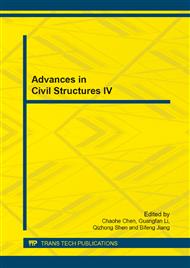[1]
Z. P. Bazant: Creep Stability and Buckling Strength of Concrete Columns. Magazine of Concrete Research. Vol. 20, nº 63. (1968), pp.85-94.
DOI: 10.1680/macr.1968.20.63.85
Google Scholar
[2]
Z.P. Bazant: Phenomenological theories for creep of concrete based on rheological models. Acta Technica CSAV. Nº 1 (1966), pp.82-109.
Google Scholar
[3]
Z. P. Bazant: Mathematical Modeling of Creep and Shrinkage of Concrete. Chapters 2 and 3. John Wiley and sons. New York (1988).
Google Scholar
[4]
A. Kawano and R. F. Warner: Model Formulations for Numerical Creep Calculations for Concrete. Journal of Structural Engineering (1996), pp.284-290.
DOI: 10.1061/(asce)0733-9445(1996)122:3(284)
Google Scholar
[5]
ANGLE. Structural Analysis Software for Finite Elements. Developed by A. Alonso. Department of Mechanics of the Continuous Medium and T. E. Universitat Politècnica de València.
Google Scholar
[6]
W. Mc Guire, R. Gallagher and R. Ziemian. Matrix structural analysis. New York: John Wiley & Sons, Inc. (2000).
Google Scholar
[7]
Asociación Española de Normalización y Certificación (AENOR) 1993. Eurocódigo 2: Proyecto de estructuras de hormigón. Parte 1-1: Reglas generales y reglas para edificación. Madrid: AENOR.
Google Scholar
[8]
Asociación Española de Normalización y Certificación (AENOR) 1996. Eurocodigo 3: Proyecto de estructuras de acero. Parte 1-1: Reglas generales y reglas para edificación. Madrid: AENOR.
Google Scholar
[9]
R. Duan, X. Huang and H. Zhang: Concrete Shrinkage and Creep Effect Prediction Model and the Influence Factors Analysis. Advanced Materials Research. Vols 756-759 (2013) p.2051-(2054).
DOI: 10.4028/www.scientific.net/amr.756-759.2051
Google Scholar
[10]
K.S. Virdi and P.J. Dowling: The Ultimate Strength of Composite Columns in Biaxial Bending. In: Proceedings of the institution of civil engineers, Part 2; 55: (1973) pp.251-72.
DOI: 10.1680/iicep.1973.4958
Google Scholar
[11]
J.Y.R. Yen: Quasi-Newton Method for Reinforced Concrete Column Analysis and Design. ASCE Journal Structural Engineering, 117(3) (1991), pp.657-66.
DOI: 10.1061/(asce)0733-9445(1991)117:3(657)
Google Scholar
[12]
E. Fenollosa and A. Alonso: Assessment of Materials Nonlinearity in Framed Structures of Reinforced Concrete and Composites. 8th International Conference on Fracture Mechanics of Concrete and Concrete Structures. (2013) pp.898-906.
Google Scholar
[13]
E. Fenollosa and I. Cabrera: Analysis of Composite Section Columns Under Axial Compression and Biaxial Bending Moments. Structures and Architecture: Concepts, Applications and Challenges. Chapter 186. Taylor & Francis Group, London. (2013).
DOI: 10.1201/b15267-209
Google Scholar


